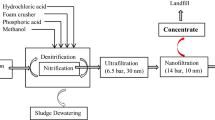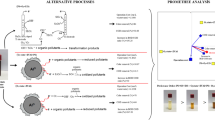Abstract
In this study, the performance of electro-peroxymonosulfate and electro-peroxydisulfate methods in biologically stabilized leachate nanofiltration concentrate treatment was investigated. To increase treatability and biodegradability of the concentrated leachate was aimed. Central composite design was applied for the optimization of process parameters and development of mathematical model. Variance analyses were performed to attain the interaction among the responses and process variables and to analyze the data. Second-order regression models were developed by Statgraphics Centurion XVI.I software program in order to estimate the removal efficiencies. Model’s correlation coefficients for COD removal through electro-peroxymonosulfate and electro-peroxydisulfate processes were determined to be 0.8769 and 0.8910, respectively, expressing conformity of the experimental data to the model. COD removal rates obtained through electro-peroxymonosulfate and electro-peroxydisulfate processes under optimum conditions (HSO5−/COD ratio: 2.5, current: 1.8 A, pH: 6.4 and reaction time: 35.9 min for electro-peroxymonosulfate process and S2O−28/COD ratio: 1.9, current: 2.1 A, pH: 5.1 and reaction time: 32.3 min for electro-peroxydisulfate process) were determined as 84.2% and 79.6%, respectively. Before advanced treatment processes, the biodegradable COD fraction of leachate nanofiltration concentrate was 12.7% and the soluble COD fraction was 78.3%. After electro-peroxymonosulfate process, biodegradable COD fraction increased to the value of 44.6% and the soluble COD fraction increased to the value of 90.5%, whereas after electro-peroxydisulfate process, biodegradable COD fraction increased to the value of 37.5% and the soluble COD fraction increased to the value of 87.4%. The results of the study showed that electro-peroxymonosulfate and electro-peroxydisulfate oxidation processes were effective treatment methods for leachate concentrates with low biodegradability.






Similar content being viewed by others
References
Abu Amr SS, Aziz HA, Adlan MN, Aziz SQ (2013a) Effect of ozone and ozone/fenton in the advanced oxidation process on biodegradable characteristics of semi-aerobic stabilized leachate. Clean Soil Air Water 41(2):148–152. https://doi.org/10.1002/clen.201200005
Abu Amr SS, Aziz HA, Adlan MN (2013b) Optimization of stabilized leachate treatment using ozone/persulfate in the advanced oxidation process. Waste Manag 33(6):1434–1441. https://doi.org/10.1016/j.wasman.2013.01.039
Alavi N, Dehvari M, Alekhamis G, Goudarzi G, Neisi A, Babaei AA (2019) Application of electro-Fenton process for treatment of composting plant leachate: kinetics, operational parameters and modeling. J Environ Health Sci 17(1):417–431. https://doi.org/10.1007/s40201-019-00361-2
Alvarez-Vazquez H, Jefferson B, Judd SJ (2004) Membrane bioreactors vs conventional biological treatment of landfill leachate: a brief review. J Chem Technol Biotechnol 79(10):1043–1049. https://doi.org/10.1002/jctb.1072
Amani-Ghadim AR, Aber S, Olad A, Ashassi-Sorkhabi H (2013) Optimization of electrocoagulation process for removal of an azo dye using response surface methodology and investigation on the occurrence of destructive side reactions. Chem Eng Process Process Intensif 64:68–78. https://doi.org/10.1016/j.cep.2012.10.012
Amor C, Torres-Socías ED, Peres JA, Maldonado MI, Oller I, Malato S, Lucas MS (2015) Mature landfill leachate treatment by coagulation/flocculation combined with Fenton and solar photo-Fenton processes. J Hazard Mater 286:261–268. https://doi.org/10.1016/j.jhazmat.2014.12.036
APHA (2005) Standard methods for the examination of water and wastewater, 21st edn. American Public Health Association (APHA), Washington, DC
Arola K, Van der Bruggen B, Mänttäri M, Kallioinen M (2019) Treatment options for nanofiltration and reverse osmosis concentrates from municipal wastewater treatment: a review. Crit Rev Environ Sci Technol 40(22):2049–2116. https://doi.org/10.1080/10643389.2019.1594519
Bajpai S, Gupta SK, Dey A, Jha MK, Bajpai V, Joshi S, Gupta A (2012) Application of central composite design approach for removal of chromium (VI) from aqueous solution using weakly anionic resin: modeling, optimization, and study of interactive variables. J Hazard Mater 227–228:436–444. https://doi.org/10.1016/j.jhazmat.2012.05.016
Bilgili MS, Demir A, Akkaya E, Ozkaya B (2008) COD fractions of leachate from aerobic and anaerobic pilot scale landfill reactors. J Hazard Mater 158:157–163. https://doi.org/10.1016/j.jhazmat.2008.01.055
Chen W, Gu Z, Wen P, Li Q (2019) Degradation of refractory organic contaminants in membrane concentrates from landfill leachate by a combined coagulation-ozonation process. Chemosphere 217:411–422. https://doi.org/10.1016/j.chemosphere.2018.11.002
Clarke BO, Anumol T, Barlaz M, Synder SA (2015) Investigating landfill leachate as a source of trace organic pollutants. Chemosphere 127:269–275. https://doi.org/10.1016/j.chemosphere.2015.02.030
Comstock SEH, Boyer TH, Graf KC (2011) Treatment of nanofiltration and reverse osmosis concentrates: comparison of precipitative softening, coagulation, and anion exchange. Water Res 45:4855–4865. https://doi.org/10.1016/j.watres.2011.06.035
Cui YH, Xue WJ, Yang SQ, Tu JL, Guo XL, Liu ZQ (2018) Electrochemical/peroxydisulfate/Fe3+ treatment of landfill leachate nanofiltration concentrate after ultrafiltration. Chem Eng J 353:208–217. https://doi.org/10.1016/j.cej.2018.07.101
Deng Y, Englehardt JD (2006) Treatment of landfill leachate by the Fenton process. Water Res 27:380–388. https://doi.org/10.1016/j.watres.2006.08.009
Deng Y, Zhao R (2015) Advanced oxidation processes (AOPs) in wastewater treatment. Curr Pollut Rep 1:167–176. https://doi.org/10.1007/s40726-015-0015-z
Esfahani KN, Farhadian M, Nazar ARS (2019) Interaction effects of various reaction parameters on the treatment of sulfidic spent caustic through electro-photo-Fenton. Int J Environ Sci Technol 16(11):7165–7174. https://doi.org/10.1007/s13762-018-2126-8
Fernandes A, Labiadh L, Ciríaco L, Pacheco MJ, Gadri A, Ammar S, Lopes A (2017) Electro-Fenton oxidation of reverse osmosis concentrate from sanitary landfill leachate: evaluation of operational parameters. Chemosphere 184:1223–1229. https://doi.org/10.1016/j.chemosphere.2017.06.088
Gengec E, Kobya M, Demirbas E, Akyol A, Oktor K (2012) Optimization of baker’s yeast wastewater using response surface methodology by electrocoagulation. Desalination 286:200–209. https://doi.org/10.1016/j.desal.2011.11.023
Guvenc SY, Dincer K, Varank G (2019) Performance of electrocoagulation and electro-Fenton processes for treatment of nanofiltration concentrate of biologically stabilized landfill leachate. J Water Process Eng 31:100863. https://doi.org/10.1016/j.jwpe.2019.100863
He R, Tian BH, Zhang QQ, Zhang HT (2015a) Effect of Fenton oxidation on biodegradability, biotoxicity and dissolved organic matter distribution of concentrated landfill leachate derived from a membrane process. Waste Manag 38:232–239. https://doi.org/10.1016/j.wasman.2015.01.006
He R, Wei XM, Tian BH, Su Y, Lu YL (2015b) Characterization of a joint recirculation of concentrated leachate and leachate to landfills with a microaerobic bioreactor for leachate treatment. Waste Manag 46:380–388. https://doi.org/10.1016/j.wasman.2015.08.006
Hilles AH, Abu Amr SS, Hussein RA, Arafa AI, El-Sebaie OD (2015) Effect of persulfate and persulfate/H2O2 on biodegradability of an anaerobic stabilized landfill leachate. Waste Manag 44:172–177. https://doi.org/10.1016/j.wasman.2015.07.046
Hu Z, Chandran K, Smets BF, Grasso D (2002) Evaluation of a rapid physical-chemical method for the determination of extant soluble COD. Water Res 36:617–624. https://doi.org/10.1016/S0043-1354(01)00273-1
Hu Y, Lu Y, Liu G, Luo H, Zhang R, Cai X (2018) Effect of the structure of stacked electro-Fenton reactor on treating nanofiltration concentrate of landfill leachate. Chemosphere 202:191–197. https://doi.org/10.1016/j.chemosphere.2018.03.103
Huang J, Chen J, Xie Z, Xu X (2015) Treatment of nanofiltration concentrates of mature landfill leachate by a coupled process of coagulation and internal micro-electrolysis adding hydrogen peroxide. Environ Technol 36:1001–1007. https://doi.org/10.1080/09593330.2014.971882
Hunce SY, Akgul D, Demir G, Mertoglu B (2012) Solidification/stabilization of landfill leachate concentrate using different aggregate materials. Waste Manag 32:1394–1400. https://doi.org/10.1016/j.wasman.2012.03.010
Ji F, Zhang H, Li J, Lai B (2017) Treatment of reverse osmosis (RO) concentrate from an old landfill site by Fe0/PS/O3 process. Chem Technol Biotechnol 92:2616–2625. https://doi.org/10.1002/jctb.5277
Karami T, Elyasi S, Amani T (2018) Modeling and optimizing of electrocoagulation process in treating phenolic wastewater by response surface methodology: precise evaluation of significant variables. Int J Environ Sci Technol 15:2389–2398. https://doi.org/10.1007/s13762-017-1539-0
Kiai H, García-Payo MC, Hafidi A, Khayet M (2014) Application of membrane distillation technology in the treatment of table olive wastewaters for phenolic compounds concentration and high quality water production. Chem Eng Process 86:153–161. https://doi.org/10.1016/j.cep.2014.09.007
Kulikowska D, Zielińska M, Konopka K (2019) Treatment of stabilized landfill leachate in an integrated adsorption–fine-ultrafiltration system. Int J Environ Sci Technol 16(1):423–430. https://doi.org/10.1007/s13762-018-1685-z
Li Q, Xu Z, Pinnau I (2007) Fouling of reverse osmosis membranes by biopolymers in wastewater secondary effluent: role of membrane surface properties and initial permeate flux. J Membr Sci 290(1–2):173–181. https://doi.org/10.1016/j.memsci.2006.12.027
Li J, Zhao L, Qin L, Tian X, Wang A, Zhou Y, Meng L, Chen Y (2016a) Removal of refractory organics in nanofiltration concentrates of municipal solid waste leachate treatment plants by combined Fenton oxidative-coagulation with photo–Fenton processes. Chemosphere 146:442–449. https://doi.org/10.1016/j.chemosphere.2015.12.069
Li Z, Yang Q, Zhong Y, Li X, Zhou L, Li X, Zeng G (2016b) Granular activated carbon supported iron as a heterogeneous persulfate catalyst for the pretreatment of mature landfill leachate. RSC Adv 6:987–994. https://doi.org/10.1039/C5RA21781D
Lin H, Wu J, Zhang H (2014) Degradation of clofibric acid in aqueous solution by an EC/Fe3+/PMS process. Chem Eng J 244:514–521. https://doi.org/10.1016/j.cej.2014.01.099
Mukherjee T, Rahaman M, Ghosh A, Bosee S (2019) Optimization of adsorbent derived from non-biodegradable waste employing response surface methodology toward the removal of dye solutions. Int J Environ Sci Technol 16(12):8671–8678. https://doi.org/10.1007/s13762-018-02184-4
Pérez G, Saiz J, Ibañez R, Urtiaga AM, Ortiz I (2012) Assessment of the formation of inorganic oxidation by-products during the electrocatalytic treatment of ammonium from landfill leachates. Water Res 46:2579–2590. https://doi.org/10.1016/j.watres.2012.02.015
Qaderi F, Sayahzadeh AH, Azizpour F, Vosughi P (2019) Efficiency modeling of serial stabilization ponds in treatment of phenolic wastewater by response surface methodology. Int J Environ Sci Technol 16:4193–4202. https://doi.org/10.1007/s13762-018-1816-6
Robinson T (2007) Membrane bioreactors: nanotechnology improves landfill leachate quality. Filtr Sep 44(9):38–39. https://doi.org/10.1016/S0015-1882(07)70288-4
Sahu O, Mazumdar B, Chaudhari PK (2019) Electrochemical treatment of sugar industry wastewater: process optimization by response surface methodology. Int J Environ Sci Technol 16(3):1527–1540. https://doi.org/10.1007/s13762-018-1765-0
Singh SK, Tang WZ (2013) Statistical analysis of optimum Fenton oxidation conditions for landfill leachate treatment. Waste Manag 33:81–88. https://doi.org/10.1016/j.wasman.2012.08.005
Talalaj IA (2014) Release of heavy metals on selected municipal landfill during the calendar year. Ann Set Environ Prot 16:404–420
Wang H, Wang Y, Li X, Sun Y, Wu H, Chen D (2016) Removal of humic substances from reverse osmosis (RO) and nanofiltration (NF) concentrated leachate using continuously ozone generation-reaction treatment equipment. Waste Manag 56:271–279. https://doi.org/10.1016/j.wasman.2016.07.040
Wang H, Wang Y, Lou Z, Zhu N, Yuan H (2017) The degradation processes of refractory substances in nanofiltration concentrated leachate using micro-ozonation. Waste Manag 69:274–280. https://doi.org/10.1016/j.wasman.2017.08.048
Xu J, Long Y, Shen D, Feng H, Chen T (2017) Optimization of Fenton treatment process for degradation ofrefractory organics in pre-coagulated leachate membrane concentrates. J Hazard Mater 323:674–680. https://doi.org/10.1016/j.jhazmat.2016.10.031
Zhang A, Gu Z, Chen W, Li Q, Jiang G (2018) Removal of refractory organic pollutants in reverse-osmosis concentrated leachate by Microwave-Fenton process. Environ Sci Pollut Res 25(29):28907–28916. https://doi.org/10.1007/s11356-018-2900-7
Zhou B, Yu Z, Wei Q, Long HY, Xie Y, Wang Y (2016) Electrochemical oxidation of biological pretreated and membrane separated landfill leachate concentrates on boron doped diamond anode. Appl Surf Sci 377:406–415. https://doi.org/10.1016/j.apsusc.2016.03.045
Acknowledgements
This research has been supported by “Scientific and Technological Research Council of Turkey (TUBITAK)” with the research project number of 118Y278. The authors wish to acknowledge ISTAC (Istanbul Metropolitan Municipality Environment Protection and Waste Material Recycling Industry and Trade J.S. Co.).
Author information
Authors and Affiliations
Corresponding author
Additional information
Editorial responsibility: Parveen Fatemeh Rupani.
Rights and permissions
About this article
Cite this article
Varank, G., Yazici Guvenc, S. & Demir, A. Electro-activated peroxymonosulfate and peroxydisulfate oxidation of leachate nanofiltration concentrate: multiple-response optimization. Int. J. Environ. Sci. Technol. 17, 2707–2720 (2020). https://doi.org/10.1007/s13762-020-02651-x
Received:
Revised:
Accepted:
Published:
Issue Date:
DOI: https://doi.org/10.1007/s13762-020-02651-x




